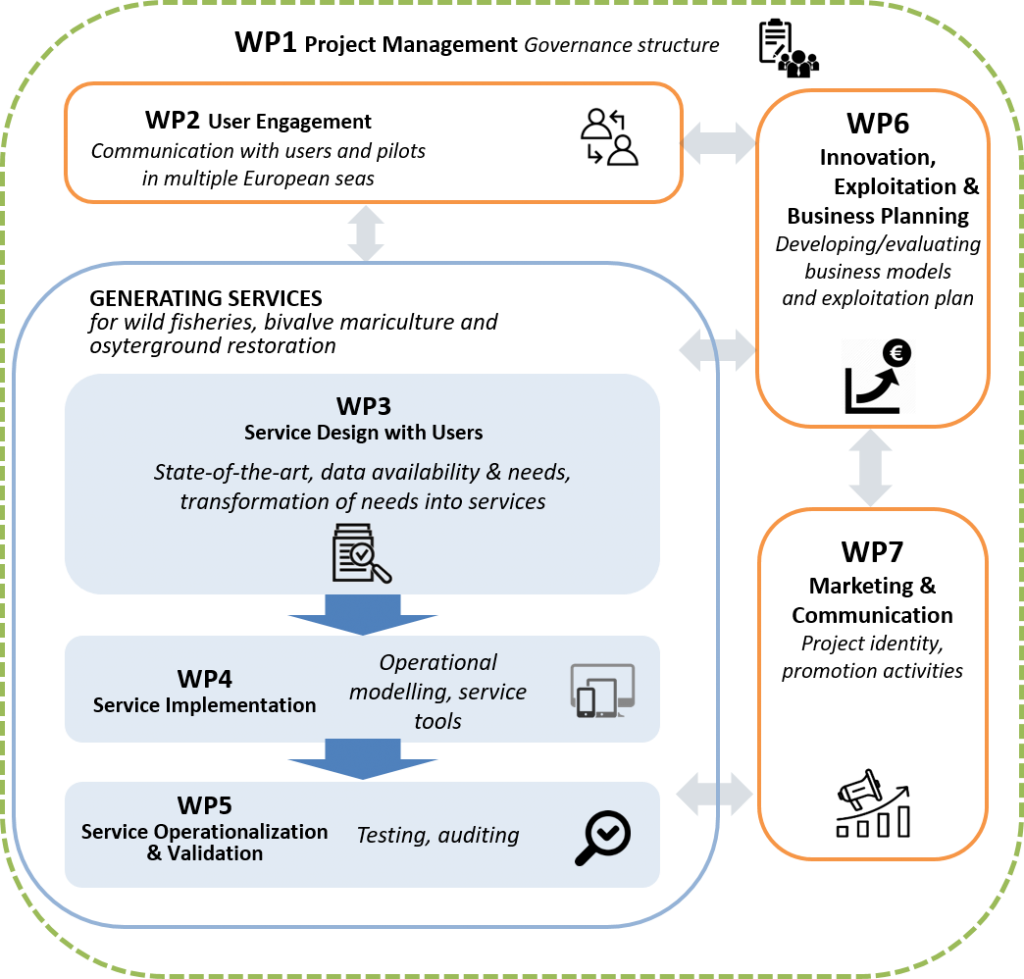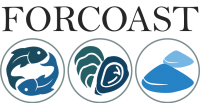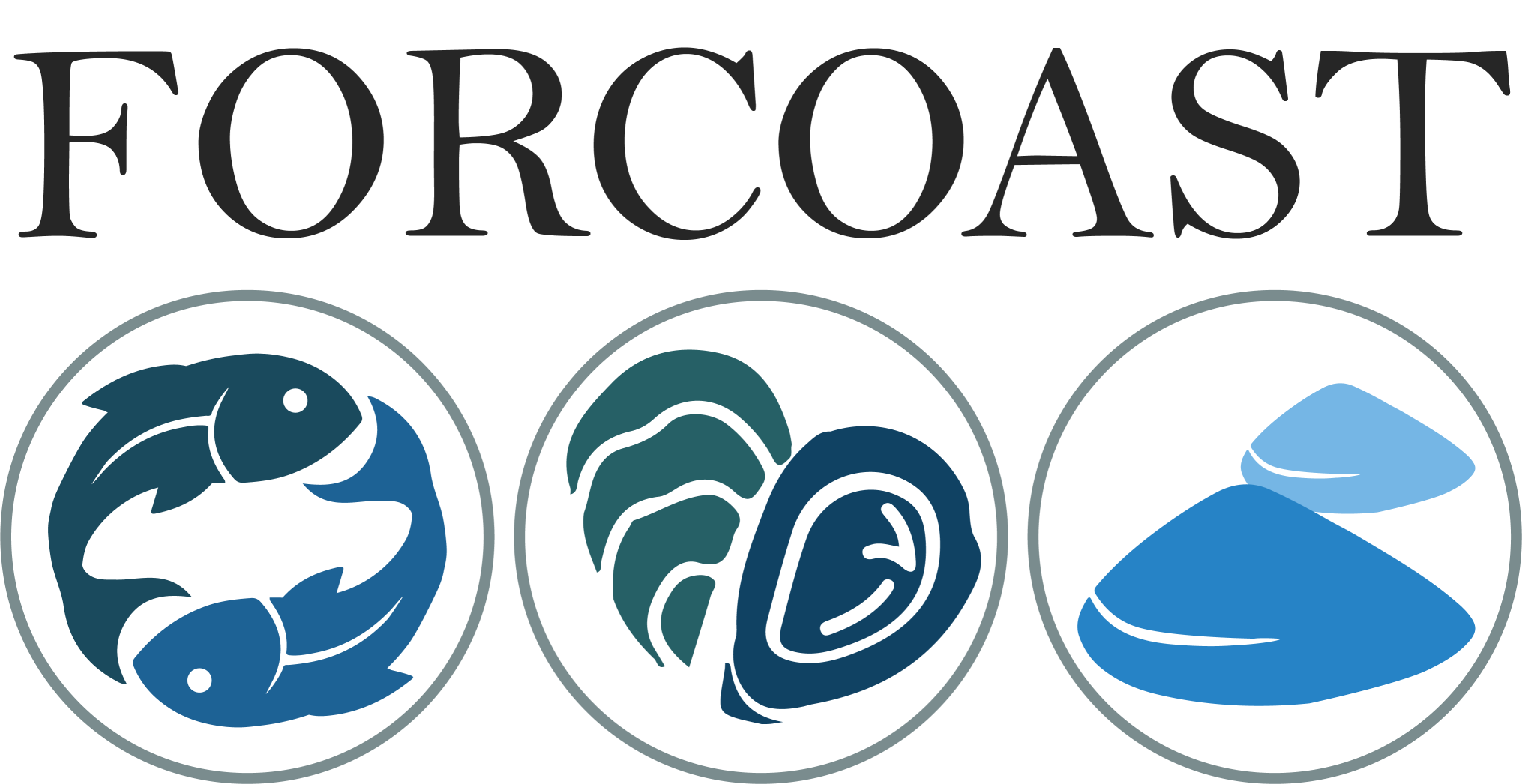FORCOAST Work Package Design
In order to achieve the proposed objectives for FORCOAST, a set of well-defined work packages to be executed in 30-month is envisaged. The proposed seven work packages (WP) follow a modular approach and a logic structure starting with the project specifications followed by the building of the system, setting up the service, assessing the market preparing a business plan and defining the communication strategies. This design accommodates for interaction between the WPs and the flows and links to external parties.

WP1 – Project Management and Coordination
The necessary governance structure for effective project direction and management is created as well as the communication flow and method for implementation are implemented. Additionally, the project performance and progress is controlled (through schedules, reports, budget, and deliverables). All risks are managed on a periodical basis to prevent delays in the project execution.
Leader: Deltares
WP2 – End User Engagement
The general objectives of WP2 is to engage users, to identify user needs, requirements and concerns in terms of specific information which is required on any aspect of the marine state, to support decision-making in the frame of their business activity. Within this WP, the Stakeholder Advisory Board (SAB) will be established. User needs and requirements will be ingested in the design of the system (WP3), implementation (WP4), demonstration and validations (WP5), and their feedback will be analysed and translated in terms of products and service specifications. The users will also be active in the dissemination of the services capability to others within their sectors.
Leader: AZTI
WP3 – Service Design
This WP will design an information service that is conforming to the user needs as identified in WP2. It will design the services according to the identified information requirements from data availability and sources to be included in the service (Earth Observation, Copernicus, in-situ and local monitoring data). It will include the different model and data components that will be incorporated in the service. The numerical forecast systems already in place in the pilot sites will be evaluated, updated and made operational according to the required services designed along with the users of each pilot. Operational models will couple, when available, waves, watersheds, meteorological and ecological models to adapt their outputs according to the needs identified for each FORCOAST pilot site. Downscaling of Copernicus and data model integration will be designed to enhance the model forecasting capability. Operational requirements of the services will be iteratively designed in cooperation with users identified in WP2. The workflow description and ultimately the products and service specifications including the desired accuracy of existing numerical models in terms of spatial and temporal resolution is to be finalized.
Leader: University of Liege
WP4 – Service Implementation
This WP is focused on the service implementation. This WP will focus on the services implementation based on the outcomes of WP3. It implements the backend and frontend architect including web and mobile clients. It develops a set of service tools among others a toolset of statistical methods, data-fusion and data-integration. It will be concluded with an implemented reliable service, with a design and functionalities following the users requirements and capable to be deployed in a DIAS or similar cloud environment.
Leader: Deltares
WP5 – Service Operability, Validation & Demonstration
This WP will demonstrate the fully functional service. This WP has two objectives. Firstly, the services developed in WP4, namely the platform with its components (i.e. outputs from numerical models, remotely sensed data products, in-situ data), will be operationalized ensuring that the platform “digests” new information provided by the above data sources and thus that the end users are provided with up to date information in a format and with the functionalities designed and developed in WP3-4. Secondly, the platform will be extensively validated in its pre-operational and then operational phases at all pilot sites. Research centres will actively engage with the end users of the platform to ensure that any shortcomings and issues are identified and addressed in the pre-operational phase and will continuously gather feedback during the operational phase. This feedback will then be presented by the Pilots to the SC in quarterly intervals for the discussion and approval of any proposed improvements that could potentially be implemented within the timeframe of the project.
Leader: Marine Institute
WP6 – Innovation Management, Exploitation & Business Planning
This WP is focused in the business itself and on the necessary actions to assure the sustainability of services after the project funding has ended. The success of a service such as FORCOAST will depend of its acceptance by the market and on the production of revenues that are enough to fully support the service exploitation and maintenance. In this perspective, the actions of this WP are critical for the service’s success. This WP will also be focused on the market assessment, the definition of a business model (how the FORCOAST consortium will organize itself to assure the service after the project funding ending) and the definition of a business plan. To achieve this goal it is necessary to identify the market requirements and the user’s will to pay for the service and to address these using adequate business models. This WP involves developing and evaluating exploitation strategies to introduce FORCOAST services in industrial settings, understanding consumers and customer behaviour and ensuring that all results and background IPR is protected. These should lead to benefits among pilots.
Leader: EV ILVO
WP7 – Marketing, Dissemination & Communication
This WP is focused on the dissemination and visibility activities to maximise the impact of the project’s results through marketing and communication of the project results to a wide range of relevant audiences.
- To ensure information about the project’s objectives, approaches and results is effectively disseminated to opinion leaders/regulators, aquaculture companies (including SMEs), the media, the scientific community and the general public by finalising a Communication and Marketing Plan.
- To give the project a corporate identity through a common graphics and a dedicated project website including dissemination materials.
- To provide impact at the end of the project through face-to-face interactions with key stakeholders, by organising a FORCOAST conference mid-term and at the end of the project in Brussels.
- To promote the use of results from the project among specific target groups: opinion leaders/regulators, policy makers, and the scientific community.
- To ensure effective and regular two-way information exchange by engagement with relevant stakeholders and a scientific advisory board.

